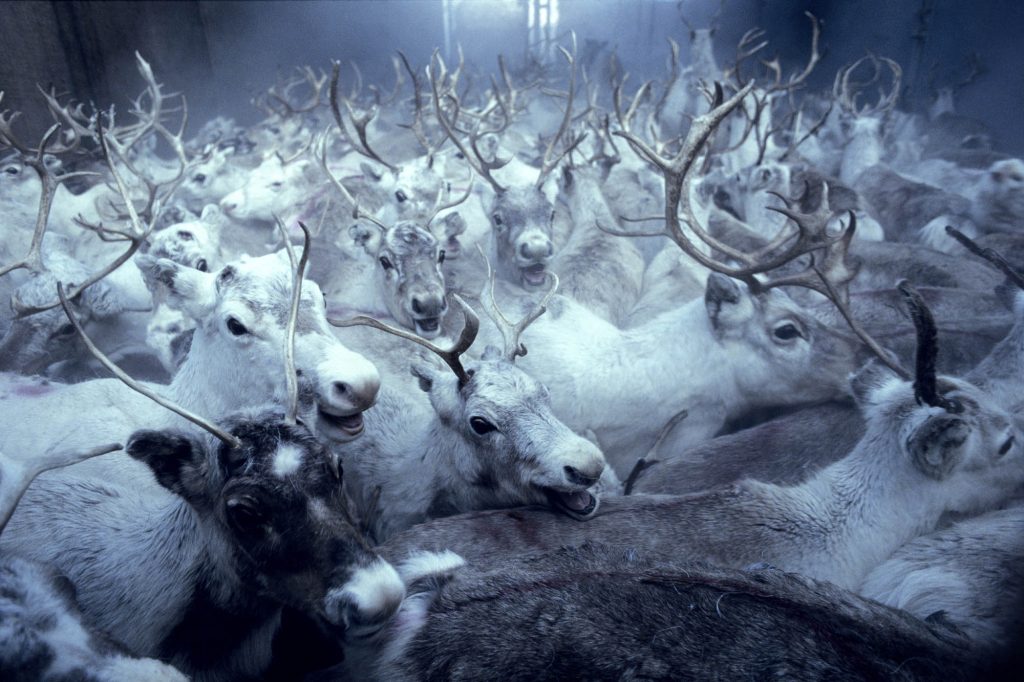Exhibit showcases Sámi reindeer herders of Northern Europe
By Michael Sun
The Canadian Museum of Nature is featuring a photographic exhibit this fall that showcases the world of the Sámi reindeer herders of Northern Europe — from the perspective of an artist of Sámi heritage.
“Frost” features images taken by Norwegian photographer Fred Ivar Utsi Klemetsen’s during 15 years of observing reindeer herders.
The exhibit opened at the McLeod Street museum on Sept. 23 and the photos will remain on display until January.
The Sámi are Artic Indigenous people living in Russia, Finland, Norway and Sweden. Klemetsen, a photographer for Bergens Tidende (The Berjen Times) since 1994, is of Sámi descent.
“I used my camera to kind of search for my own heritage and background,” Klemetsen said. He recalled how the first pictures he ever took, at age 12, were of Sámi reindeer herders.

Spring migration can be very hard. For some animals, it is too hard. This little fellow was eventually transported by sled. Fred Ivar Utsi Klemetsen, courtesy of Royal Norwegian Embassy
Klemetsen said the photos are an attempt to depict an “honest” reflection of the reindeer herders.
“For me, it’s really important not to show [just the] beauty of it,” he said. “It’s important to show the daily life…I haven’t tried to hide anything. For me it’s important to show exactly how it is.”
The exhibit was at the Smithsonian Museum of Natural History in 2006 in Washington, D.C. and at the Gladstone Hotel in Toronto in 2014. The Ottawa run ends on Jan. 7.
“Frost” features 30 photos, including five new photographs not previously displayed, according to Stacy Wakeford, the museum’s director of exhibits.
She said the exhibit builds on the museum’s Artic theme this year, including the Canada Goose Arctic Gallery and Nordic Day events being held from Oct. 19-21.
“We thought: this is really interesting and could work in one of our spaces,” Wakeford said.
The exhibit is presented by the Royal Norwegian Embassy. The embassy, located on Metcalfe Street, approached the museum last December about the exhibit and helped organize it, said Jan-Terje Storaas, the embassy’s cultural affairs and communications officer.
Storaas said he hopes the exhibit will attract a variety of people, in particular Indigenous Canadians: “It’s important for them to connect with other Indigenous groups around the world.”
The embassy plans to reach out to Indigenous groups in Ottawa to invite them to see the exhibit.
“There’s some really wonderful images of Artic landscape, the lighting — everything is very unique up there, so I think people will appreciate that,” Storaas said.
Storaas said the Sámi reindeer herders make the exhibit unique. “It’s a lifestyle that is not very common,” he said.
According to Wakeford, the cultural elements of the Sámi story differ from the museum’s other exhibits and make it particularly engaging.
“Putting humans back into the story of nature…we think it’s really important for our visitors to kind of make those personal connections,” she said, “and not see nature as something that’s outside their experience but as something that is part of their life and their world.”
The reindeer herders are important for the Sámi culture, according to Klemetsen.
“For me, it’s really important to make a documentation of that (lifestyle). I’m not sure if it’s going to disappear, but it’s definitely going to change,” he said.
He said the herders are special because they connect more with historical Sámi traditions than do other Sámis, like himself. “They are actually dealing with the animals,” he said.
Klemetsen, whose grandfather was a reindeer herder, noted the photographic experience helped him discover his own heritage.
“For me, it has been a really sadness of my life that I didn’t learn the Sámi language,” he said. “I feel like I’m not a good enough Sámi.”
“In a way to show and make these photographs, it has been a really important thing for myself just to recognize me as a Sámi, to be proud of being a Sámi.”
Klemetsen said he hopes the Sámi reindeer herders’ tradition is preserved.
“I hope people learn from that exhibit it is important to take care of (Sámi reindeer herders), even if there aren’t that many people – like in Norway, 1,500 people,” he said. “That’s a really small group of people, but it’s really, really important for the culture.”

